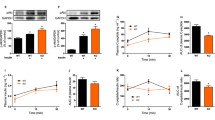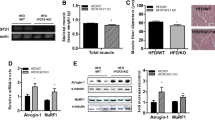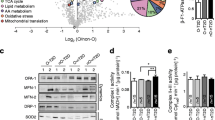Abstract
Fibroblast growth factor (FGF) 21, was identified as a potent metabolic regulator of glucose and lipid metabolism. We investigated whether the levels and signalings of FGF21 changed in the skeletal muscle of type 2 diabetes mellitus (T2DM) patients, participants with impaired glucose tolerance (IGT), human skeletal muscle myotubes (HSMMs) under insulin-resistant conditions, and mice with diet-induced obesity (DIO). A percutaneous biopsy sample of the vastus lateralis muscle of T2DM patients, IGT subjects, and participants with normal glucose tolerance was obtained and the levels and signalings of FGF21 were assessed. We determined whether the expression and signalings of FGF21 in HSMMs altered according to palmitate concentrations and exposure time. Also, we confirmed whether changes of FGF21 signal transduction resulted in the alteration of FGF21 functions. DIO mice were treated intravenously with recombinant FGF21, and the levels and signalings of FGF21 were assessed in their soleus muscles. We checked whether or not FGF21 played a role in the gene transcription related to lipid oxidation. Levels of FGF21 increased, whereas levels of phosphorylated FGF receptor (p-FGFR), phosphorylated FGFR substrates 2α (p-FRS2α), and phosphorylated extracellular signal-regulated kinases (p-ERK) decreased in the skeletal muscle of both T2DM patients and IGT subjects. In vitro, palmitate increased the levels of FGF21 and significantly reduced the levels of β-klotho, p-FGFR, p-FRS2α, and p-ERK1/2 in HSMMs exposed to palmitate. Palmitate also decreased glucose uptake and glycogen contents of FGF21. Consistently, the levels of FGF21 were significantly higher and the levels of β-klotho and p-FGFR were lower in the DIO mice than in normal lean mice. The levels of FGF21 increased but its signal transduction and actions were impaired in skeletal muscles of T2DM patients, IGT subjects, in insulin-resistant HSMMs, and DIO mice.





Similar content being viewed by others
References
T. Nishimura, Y. Nakatake, M. Konishi, N. Itoh, Identification of a novel FGF, FGF-21, preferentially expressed in the liver. Biochim. Biophys. Acta 1492, 203–206 (2000)
A. Kharitonenkov, T.L. Shiyanova, A. Koester, A.M. Ford, R. Micanovic, E.J. Galbreath et al., FGF-21 as a novel metabolic regulator. J. Clin. Invest. 115, 1627–1635 (2005)
A. Kharitonenkov, V.J. Wroblewski, A. Koester, Y.F. Chen, C.K. Clutinger, X.T. Tigno et al., The metabolic state of diabetic monkeys is regulated by fibroblast growth factor-21. Endocrinology 148, 774–781 (2007)
Y. Hotta, H. Nakamura, M. Konishi, Y. Murata, H. Takagi, S. Matsumura et al., Fibroblast growth factor 21 regulates lipolysis in white adipose tissue but is not required for ketogenesis and triglyceride clearance in liver. Endocrinology 150, 4625–4633 (2009)
T. Coskun, H.A. Bina, M.A. Schneider, J.D. Dunbar, C.C. Hu, Y. Chen et al., Fibroblast growth factor 21 corrects obesity in mice. Endocrinology 149, 6018–6027 (2008)
M. Mraz, M. Bartlova, Z. Lacinova, D. Michalsky, M. Kasalicky, D. Haluzikova et al., Serum concentrations and tissue expression of a novel endocrine regulator fibroblast growth factor-21 in patients with type 2 diabetes and obesity. Clin. Endocrinol. (Oxf) 71, 369–375 (2009)
R.D. Semba, K. Sun, J.M. Egan, C. Crasto, O.D. Carlson, L. Ferrucci, Relationship of serum fibroblast growth factor 21 with abnormal glucose metabolism and insulin resistance: the Baltimore Longitudinal Study of Aging. J. Clin. Endocrinol. Metab. 97, 1375–1382 (2012)
A.O. Chavez, M. Molina-Carrion, M.A. Abdul-Ghani, F. Folli, R.A. Defronzo, D. Tripathy, Circulating fibroblast growth factor-21 is elevated in impaired glucose tolerance and type 2 diabetes and correlates with muscle and hepatic insulin resistance. Diabetes Care 32, 1542–1546 (2009)
F.M. Fisher, P.C. Chui, P.J. Antonellis, H.A. Bina, A. Kharitonenkov, J.S. Flier et al., Obesity is a fibroblast growth factor 21 (FGF21)-resistant state. Diabetes 59, 2781–2789 (2010)
L.L. Listenberger, D.S. Ory, J.E. Schaffer, Palmitate-induced apoptosis can occur through a ceramide-independent pathway. J. Biol. Chem. 276, 14890–14895 (2001)
E.S. Muise, B. Azzolina, D.W. Kuo, M. El-Sherbeini, Y. Tan, X. Yuan et al., Adipose fibroblast growth factor 21 is up-regulated by peroxisome proliferator-activated receptor gamma and altered metabolic states. Mol. Pharmacol. 74, 403–412 (2008)
A. Beenken, M. Mohammadi, The FGF family: biology, pathophysiology and therapy. Nat. Rev. Drug Discov. 8, 235–253 (2009)
M.J. Potthoff, T. Inagaki, S. Satapati, X. Ding, T. He, R. Goetz et al., FGF21 induces PGC-1alpha and regulates carbohydrate and fatty acid metabolism during the adaptive starvation response. Proc. Natl. Acad. Sci. USA 106, 10853–10858 (2009)
W. Wente, A.M. Efanov, M. Brenner, A. Kharitonenkov, A. Koster, G.E. Sandusky et al., Fibroblast growth factor-21 improves pancreatic beta-cell function and survival by activation of extracellular signal-regulated kinase 1/2 and Akt signaling pathways. Diabetes 55, 2470–2478 (2006)
D.A. Sarruf, J.P. Thaler, G.J. Morton, J. German, J.D. Fischer, K. Ogimoto et al., Fibroblast growth factor 21 action in the brain increases energy expenditure and insulin sensitivity in obese rats. Diabetes 59, 1817–1824 (2010)
K.H. Kim, Y.T. Jeong, H. Oh, S.H. Kim, J.M. Cho, Y.N. Kim et al., Autophagy deficiency leads to protection from obesity and insulin resistance by inducing Fgf21 as a mitokine. Nat. Med. 19, 83–92 (2013)
P. Hojman, M. Pedersen, A.R. Nielsen, R. Krogh-Madsen, C. Yfanti, T. Akerstrom et al., Fibroblast growth factor-21 is induced in human skeletal muscles by hyperinsulinemia. Diabetes 58, 2797–2801 (2009)
F.L. Mashili, R.L. Austin, A.S. Deshmukh, T. Fritz, K. Caidahl, K. Bergdahl et al., Direct effects of FGF21 on glucose uptake in human skeletal muscle: implications for type 2 diabetes and obesity. Diabetes Metab. Res. Rev. 27, 286–297 (2011)
M.S. Lee, S.E. Choi, E.S. Ha, S.Y. An, T.H. Kim, S.J. Han et al., Fibroblast growth factor-21 protects human skeletal muscle myotubes from palmitate-induced insulin resistance by inhibiting stress kinase and NF-kappaB. Metabolism 61, 1142–1151 (2012)
K. Mai, J. Andres, K. Biedasek, J. Weicht, T. Bobbert, M. Sabath et al., Free fatty acids link metabolism and regulation of the insulin-sensitizing fibroblast growth factor-21. Diabetes 58, 1532–1538 (2009)
K.M. Habegger, K. Stemmer, C. Cheng, T.D. Muller, K.M. Heppner, N. Ottaway et al., Fibroblast growth factor 21 mediates specific glucagon actions. Diabetes 62, 1453–1463 (2013)
M.K. Badman, P. Pissios, A.R. Kennedy, G. Koukos, J.S. Flier, E. Maratos-Flier, Hepatic fibroblast growth factor 21 is regulated by PPARalpha and is a key mediator of hepatic lipid metabolism in ketotic states. Cell Metab. 5, 426–437 (2007)
K.H. Bae, J.G. Kim, K.G. Park, Transcriptional regulation of fibroblast growth factor 21 expression. Endocrinol. Metab. (Seoul) 29, 105–111 (2014)
F.M. Fisher, J.L. Estall, A.C. Adams, P.J. Antonellis, H.A. Bina, J.S. Flier et al., Integrated regulation of hepatic metabolism by fibroblast growth factor 21 (FGF21) in vivo. Endocrinology 152, 2996–3004 (2011)
M.A. Lemmon, J. Schlessinger, Cell signaling by receptor tyrosine kinases. Cell 141, 1117–1134 (2010)
Y. Ogawa, H. Kurosu, M. Yamamoto, A. Nandi, K.P. Rosenblatt, R. Goetz et al., BetaKlotho is required for metabolic activity of fibroblast growth factor 21. Proc. Natl. Acad. Sci. USA 104, 7432–7437 (2007)
H. Kurosu, M. Choi, Y. Ogawa, A.S. Dickson, R. Goetz, A.V. Eliseenkova et al., Tissue-specific expression of betaKlotho and fibroblast growth factor (FGF) receptor isoforms determines metabolic activity of FGF19 and FGF21. J. Biol. Chem. 282, 26687–26695 (2007)
J. Diaz-Delfin, E. Hondares, R. Iglesias, M. Giralt, C. Caelles, F. Villarroya, TNF-alpha represses beta-Klotho expression and impairs FGF21 action in adipose cells: involvement of JNK1 in the FGF21 pathway. Endocrinology 153, 4238–4245 (2012)
W.Y. So, Q. Cheng, L. Chen, C. Evans-Molina, A. Xu, K.S. Lam et al., High glucose represses beta-klotho expression and impairs fibroblast growth factor 21 action in mouse pancreatic islets: involvement of peroxisome proliferator-activated receptor gamma signaling. Diabetes 62, 3751–3759 (2013)
C. Schmitz-Peiffer, Signalling aspects of insulin resistance in skeletal muscle: mechanisms induced by lipid oversupply. Cell Signal. 12, 583–594 (2000)
A.R. Martins, R.T. Nachbar, R. Gorjao, M.A. Vinolo, W.T. Festuccia, R.H. Lambertucci et al., Mechanisms underlying skeletal muscle insulin resistance induced by fatty acids: importance of the mitochondrial function. Lipids Health Dis. 11, 30 (2012)
G.I. Shulman, Cellular mechanisms of insulin resistance. J. Clin. Invest. 106, 171–176 (2000)
Acknowledgments
This study was supported by a grant of the Korea Healthcare Technology R&D Project, Ministry of Health and Welfare (HI12C1006/A121102 to K.W. Lee) and Basic Science Research Program through the National Research Foundation of Korea, Ministry of Science, ICT & Future Planning (NRF-2014R1A1A3050777 to H.J. Kim), Republic of Korea. The biospecimens (liver tissue) for this study were provided by the Ajou Human Bio-Resource Bank (AHBB), a member of the National Biobank of Korea, which is supported by the Ministry of Health and Welfare. Liver tissues derived from the National Biobank of Korea were obtained with informed consent under institutional review board-approved protocols.
Author contribution
JYJ designed the study, analyzed data, and wrote the manuscript. SEC designed the study, performed experiments, analyzed data, and wrote the manuscript. ESH, JGJ performed experiments, and analyzed data. THK analyzed data, and wrote the manuscript. SJH, HJK, DJK, and YK contributed to the discussion and reviewed and edited the manuscript. KWL designed the study and wrote the manuscript. All authors contributed to data interpretation and reviewed and approved the final manuscript. KWL is the guarantor of this work and, as such, had full access to all the data in the study and takes responsibility for the integrity of the data and the accuracy of the data analysis.
Author information
Authors and Affiliations
Corresponding author
Ethics declarations
Conflict of interest
All the authors declare that they have no conflict of interests.
Electronic supplementary material
Below is the link to the electronic supplementary material.
12020_2015_845_MOESM1_ESM.tif
Supplemental Fig. 1 The original Western blot of figure 1. The numbers 1 and 2 are indications of the identical subject repeated in each blot. FGF, Fibroblast growth factor; p-FGFR, phosphorylated fibroblast growth factor receptor; p-FRS2α, phosphorylated fibroblast growth factor receptor substrates 2α; T2DM, type 2 diabetes mellitus patients; IGT, subjects with impaired glucose tolerance; NGT, participants with normal glucose tolerance.. Supplementary material 1 (TIFF 248 kb)
12020_2015_845_MOESM2_ESM.tif
Supplemental Fig. 2 Validation of β-klotho. (A) β-klotho protein in human skeletal muscle myotubes (HSMMs), (B) knock down of β-klotho using β-klotho siRNA, (C) FGF21 signaling proteins with or without β-klotho siRNA. HSMMs were transfected with siRNA β-klotho, incubated for 24h, differentiated and then treated with palmitate 200 μM for 24 h. Levels of β-klotho were significantly decreased after treatment of siRNA β-klotho and after treatment of palmitate. PA, palmitate; BSA, Bovine serum albumin; FGF, Fibroblast growth factor; p-FRS2α, phosphorylated fibroblast growth factor receptor substrates 2α; p-ERK1/2, phosphorylated extracellular signal-regulated kinases 1 and 2. Supplementary material 2 (TIFF 108 kb)
12020_2015_845_MOESM3_ESM.tif
Supplemental Fig. 3 Expression of β-klotho in each tissue from C57BL/6J mice. (A) the expression of β-klotho in adipose tissue and (B) in a few other tissues. To investigate β-klotho expression in a few tissues of mice, tissues from liver, gastrocnemius muscle, soleus muscles, and epididymal fat of normal diet mice and only epididymal fat of DIO mice were isolated, then the levels of β-klotho, using western blotting were measured. The levels of β-klotho were high in liver, adipose tissue from normal mice, and soleus muscles, but epididymal fat from DIO mice and gastrocnemius muscle weakly expressed β-klotho. DIO, diet-induced obesity model with high fat diet; GAPDH, glyceraldehyde-3-phosphate dehydrogenase.. Supplementary material 3 (TIFF 113 kb)
12020_2015_845_MOESM4_ESM.tif
Supplemental Fig. 4 FGF21 signal transduction in gastrocnemius muscle, and soleus muscles of normal C57BL/6J mice. FGF21 stimulated tyrosine phosphorylation of FRS2α and ERK in soleus muscles, not gastrocnemius muscle in normal mice. Normal mice were injected via the tail with FGF21 (50 mg/kg) then after 15 min, liver, gastrocnemius muscle, and soleus muscles were isolated. The β-klotho protein was strongly detected in soleus muscles than in gastrocnemius muscle. The levels of p-FRS2 and p-ERK increased more in response to FGF21 in soleus muscles than in gastrocnemius muscle. FGF21 signaling was measured by immunoprecipitation (IP, FRS2 antibody)/immunoblot (IB, p-Y). Phosphorylated and total ERK and phosphorylated and total FRS2 were detected by immunoblot using each antibody. FGF21, fibroblast growth factor 21; p-FRS2α, phosphorylated fibroblast growth factor receptor substrates 2α; p-ERK1/2, phosphorylated extracellular signal-regulated protein kinases 1 and 2. Supplementary material 4 (TIFF 127 kb)
12020_2015_845_MOESM5_ESM.tif
Supplemental Fig. 5 Gene expression by FGF21 in soleus muscles of normal mice. FGF21 stimulated expression of peroxisome proliferator-activated receptor α. Normal mice were injected via the tail with FGF21 (50 mg/kg) then after 15 min, soleus muscles were isolated. The mRNA expression was measured by qRT-PCR. ppara, peroxisome proliferator-activated receptor α; pparb/d peroxisome proliferator-activated receptor β/δ; mcad, medicum-chain acul-coenzyme A dehydrogenase. Data represent mean ± SEs. †P < 0.05 vs. normal without FGF21. Supplementary material 5 (TIFF 63 kb)
12020_2015_845_MOESM6_ESM.tif
Supplemental Fig. 6 Expression of β-klotho in each tissue from humans. To compare the levels of β-klotho expressions, samples from the liver, vastus lateralis, and subcutaneous fat of different subjects were obtained, then the levels of β-klotho, using western blotting were measured. Although the levels of β-klotho were relatively weaker than that of adipose tissue, the human muscle did show an expression of β-klotho. Supplementary material 6 (TIFF 106 kb)
Rights and permissions
About this article
Cite this article
Jeon, J.Y., Choi, SE., Ha, E.S. et al. Association between insulin resistance and impairment of FGF21 signal transduction in skeletal muscles. Endocrine 53, 97–106 (2016). https://doi.org/10.1007/s12020-015-0845-x
Received:
Accepted:
Published:
Issue Date:
DOI: https://doi.org/10.1007/s12020-015-0845-x




